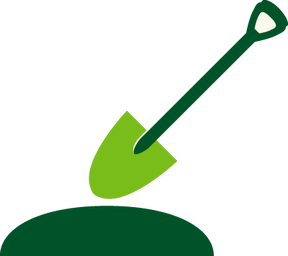Planting Tips - Shrubs
chevron_leftchevron_right

Plant at the right time
- While spring and fall remain the optimal times for shrub planting in Ontario, suitable climate zoned shrubs can be planted anytime of year as long as the ground is not frozen or can be worked easily and water is available.
- Minimizing planting stress is best when the soil temperatures are above 8 degrees celsius.
chevron_leftchevron_right

Identify the location you want to plant on your property and ask the following questions
- How much sunlight does your planting location get per day?
- Does this area get normal levels of rainfall or is it in a location under overhangs or dense tree coverage?
- Do you have access to water?
- What's your soil like? Is it sandy and well-drained or heavy and holds moisture? If you are unsure try performing water-holding capacity tests.
chevron_leftchevron_right

Know how big each shrub grows
- Check the height and spread measurements when planting a shrub.
- Knowing the mature size will help in providing the correct space, this will allow for adequate air circulation and room for growth.
chevron_leftchevron_right

Match the shrub to the location you choose
- Select plants that are well-adapted to the local climate. Know your Zone.
- Use the search filters to select appropriate plants for sunlight levels.
- Use the search filters to select appropriate plants for soil moisture levels or amend the soil to increase or decrease water holding capacity.
chevron_leftchevron_right

Determine the hole size required to plant
- The width of the hole should be 1-2 times the width of the root ball you are planting. This extra width allows the roots to easily spread out and establish themselves in the loose soil when you backfill the hole.
- Identify the root flare. Remove the top few cm of soil until you identify the root flare. "Root flare" refers to the area at the base of the shrub where the roots meet the trunk. This area is important for the shrub's stability and integral to allow the exchange of nutrients between the shrub and the soil.
- The depth of the hole should be determined by measuring the top of the root flare to the bottom of the root ball. The root flare should not be buried too deep or lifting too high at planting so measure a few times and make sure this is correct when digging the hole. Ideally the root flare is flush with the finished soil grade.
chevron_leftchevron_right

Amending the soil
- In most circumstances it is beneficial to mix a composted manure or leaf waste with the existing soil before back filling. A recommended rate is 1 part compost to 4 parts existing soil.
chevron_leftchevron_right

Preparing shrubs in different packaging
If you are getting Ready to Plant a Container Shrub
- Remove the container (packaging). Lift the shrub slightly off the ground by securely grabbing onto the base of the stems. With your free hand tap around the edge of the container until it slides off the root ball. For larger container shrubs ask for assistance as this may be difficult with one person.
- Inspect the roots. If the plant has an established root system, break up or cut the roots that are circling with a sharp spade or pruning shear. If the container is densely rooted it is recommended to shave the outside of the rootball (up to 5cm) with a sharp spade or pruning saw.
If you are getting Ready to Plant a Wire Basket Shrub
- It is recommended to hire a professional landscape contractor as machinery is often required to plant a wire basket shrub. You may reach out to us through our Landscape Partner Program and we can connect you with a professional.
- Tying up the stems will help the planting process go much smoother. It will help protect against damaging branches and will give you more visibility and room to remove burlap, wire and backfilling the hole. Note: Do not forget to remove all the materials you used to tie up the branches when your planting is complete.
- Lower the wire basket shrub inside the hole using a machine. Using chains to hook onto the basket can be an effective way to lower the shrub into the hole safely. Keep the chains on until you've correctly positioned the shrub as you may need to remove or add soil at this stage while the basket is intact. See below under Planting Time! for when to remove burlap and strings.
If you are Getting Ready to Plant a Bareroot Shrub
- Carefully inspect the roots before planting a bareroot shrub. Prune any damaged or broken roots.
- Lightly trim each root as this helps stimulate new root growth. When roots are cut, it encourages the development of new feeder roots which are essential for the shrub to absorb water and nutrients from the soil. This process can help the shrub establish more quickly after planting.
- Once the roots are pruned, soaking the bareroot shrubs for 2 hours prior to planting is recommended to ensure they are well-hydrated.
- It is important throughout the planting process to keep the roots from drying out. During each step keep them somewhere cool, out of direct sun and water them regularly until they are planted.
chevron_leftchevron_right

Planting time!
- Once the shrub is in the hole. Reassess that your hole depth is equal to the height of the root flare. Adjust by adding or removing soil from the bottom Note: It is okay for the root flare to be slightly above the height of the hole to allow for the soil and roots to settle after watering or allow a layer of mulch after planting.
- Position the shrub in the hole making sure it is in a vertical position.
- Back fill with the amended soil to roughly half the hole depth.
- Use the end of your shovel or foot to gently tamp the soil around your plant until you feel the shrub is stable and vertical inside the hole. Adding water at this stage will help settle the soil and fill in any potential air pockets around your root ball.
- If you are planting a wire basket, this is a good time to remove the burlap and twine from around the base of the stems and the top of the rootball. Use a pair of wire cutters to remove the top third of the basket. Note: It is okay to leave the bottom 2/3rd of the basket to help keep the shrub stable. This will not affect the growth of the root system.
- Continue to add soil until it is filled to the top of the hole. Any extra soil can be used to create a "tree well" around the trunk to keep water and nutrients from escaping during waterings.
chevron_leftchevron_right

Know when to water and how much
- Water newly planted shrubs thoroughly after planting and continue until they are established. There are easy-to-use tools to measure soil moisture, although visual inspection and digging up some soil and feeling it can be just as reliable.
- Consider time of year and weather conditions. Factors like temperature, humidity and rainfall influence how quickly the soil dries out.
- Adjust based on needs. Some shrubs have specific water needs. Confirm the ones you chose and adjust accordingly.
- Mulching is optional although a layer of mulch around the base of the shrub can help retain soil moisture and reduce the need to water as often. Note: Be careful not to apply mulch too heavy around the trunk of the shrub as this can lead to problems such as crown rot and create habitats for rodents that chew on bark.
- Morning waterings are preferred. Watering in the morning allows the ground to absorb moisture before the heat of the day evaporates it.
- Adjust as the plant establishes. Shrubs will develop roots over the next 2 years and will become more resilient to longer periods without watering. Keep monitoring and gradually adjust based on the shrub's growth and visual inspections.

